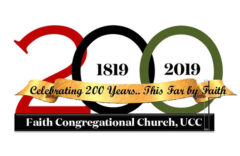Citizens of Color, 1863-1890:
Black society after the Civil War
In the nineteenth century, there were five Black churches. That number was probably due more to the variety of beliefs than a reflection of the number of Black neighborhoods in Hartford.
According to the Hartford Black History Project, “Although the Front Street Black Neighborhood was not the oldest, its Talcott Street Congregational Church (the “African Church”) built in 1823 is the first Black Church in the city. The Black population in Hartford until then relied on the white churches if they went to church at all. One suspects that the Talcott Street Church probably arose as a result of the formation of a sense of Black community in Hartford, for it was not only associated with the riot of 1835, but later with the abolitionist movement in the Black community. So, while the Park River Black Neighborhood was probably older, it was perhaps socially less viable than the Front Street Black Neighborhood that arose near all the shipping activity along the Connecticut River.”

The other primary “African” church in Hartford was the American Methodist Episcopal Zion Church (African), which was established in 1836 at 269 Pearl Street to serve the needs of the nearby Park River Black Neighborhood. In 1857 the church was rebuilt at 91 Pearl Street. The building shown in this lithograph from Geer’s Hartford Directory (Connecticut Historical Society Library) is identified as the new church, but on architectural grounds it seems more likely to be the original building of 1836. It was built for $6000 and could seat 445 people. Although it might seem modest today, it was at the time among the City’s major constructions.

Here in fact is the new A.M.E. Zion church, but in the Italianate style one might expect for 1857. It stood at the southwest corner of Pearl and South Ann Street, right at the northern edge of the old Park River Black Community. At the left of the photo we look south down Ann Street, which ended a block away at the Park River. So we would be looking right into Hartford’s oldest Black community, except that by the time this picture was taken in June 1898, the entire neighborhood had been displaced and the church was being relocated to North Main Street. The building seen to the right of the church was the fire department which now occupies the land on which stood the church.
We associate the Baptist religion with the wave of southern migration, and indeed, Shiloh Baptist (not at its present location) was established in 1889. Thanks to the first wave of migration, it became the largest Black Church in Harford and prospered around the time of World War I. The Union Baptist Church, was built on Mather Street a little earlier in 1871. Further investigation might show that while the target of the first wave of southern migration was the Windsor Street Neighborhood, it grew to include the early settlement near Mather Street and what had been called “Nigger Lane.” There was also built on Mather Street St. Monica’s Episcopal Church in 1912. The absence of an earlier church in the area might be because folk went to the Talcott Street Church, which was closer.
| Holdridge Primus The Primus family can be traced back to a Black freeman, simply named Primus, who was servant and apprentice of a Dr. Wolcott in the mid-18th century East Windsor area. He went on to become a doctor himself. One of his immediate descendents was the sailor, Ham Primus, whose service was so outstanding he gained a status rare for Blacks: American citizenship. He married Temperance Asher, and their children were an important part of Hartford’s early Black community. Holdridge Primus was one of their children. This is a photo of him from the article, “The Colored People Who Live in Hartford,” in the Hartford Courant of 24 October 1915. |
| Holdridge was employed as a clerk at Humphrey and Syms, which sold sugar, coffee and tea, during much of his life and eventually became a silent partner. Here he can be seen standing in the light snow in about 1860 in front of the store (Connecticut Historican Society Museum). He married Mehitable Jacobs, a dressmaker and a founder of the Talcott Street Congregational Church. By 1850 the couple had acquired a home at 20 Wadsworth Street, and were considered wealthy for a Black family. Among their four children was Rebecca, who was a Maryland schoolteacher with the Freedman’s Bureau, where she sought to advance the condition of Black people. When she returned to Hartford she married a Charles Thomas and fell into obscurity, but continued to teach at the Talcott Street Church school. |
Read more history of Hartford’s African American community and Faith Church HERE.
300 total views , 1 views today
